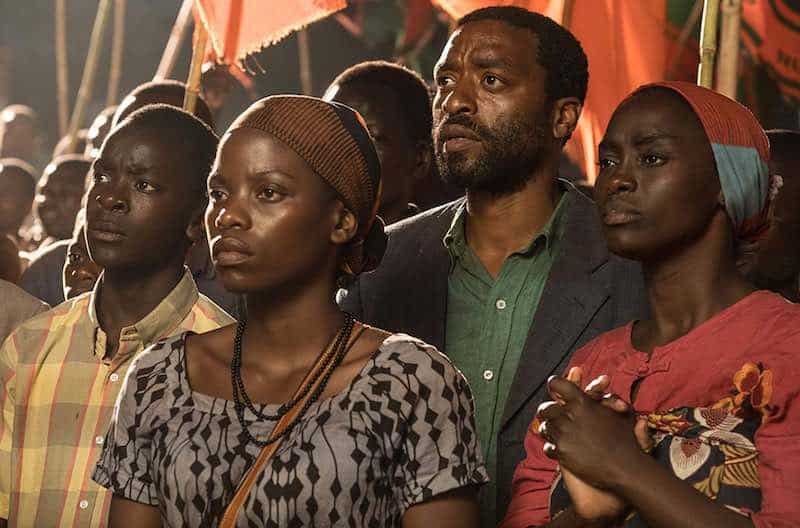Chiwetel Ejiofor adapted the novel by William Kamkwamba telling this true story. He also directed and starred in The Boy Who Harnessed the Wind. It was his first ever directing effort. There are spoilers ahead.
The Boy Who Harnessed the Wind takes a slow, character-driven look at an environmental disaster that cost people’s lives.

We see the story through the plight of the Kamkwamba family. Trywell (Ejiofor) is the father, a farmer in Malawi. William (Maxwell Simba) is the teenaged boy, who longs to go to school and learn science. His older sister Annie (Lily Banda) has been lucky enough to go to school and applied for university. His mother Agnes (Aïssa Maïga) supports her children’s efforts to learn and better themselves.
Agnes took the credit for how smart her two children were. Trywell was a smart man, but his pride and his stubbornness made him do foolish things that almost led to disaster.
Their prosperity is ruined when lumbermen, backed by the government, come in and convince many local landowners to sell their trees. Those trees were the only thing between the rains and floods. After a particularly heavy rainy season and damaging floods, there was a long drought.
The Kamkwamba family, like everyone else in the area trying to live by farming, faced starvation. People grew desperate. They stole food from each other. Fights over grain grew common. People began leaving the area.
Trywell wouldn’t leave.
While this slow decline took place (the movie runs an hour and 53 minutes, which felt waayyy too long), William goes to school until the money runs out. When he realizes his sister Annie and the science teacher have a thing going, he uses that information to illegally attend only the science classes.
This teacher had a generator (they call it a dynamo) on his rear bicycle wheel that ran a headlight for the bike when the wheel turned. William is mechanically insightful. He understands batteries and radios. But he doesn’t understand how motion creates power for the light. The teacher merely said it used magnets, but he didn’t really explain how it worked.
William finagles his way into spending time in the library, even though he has no library card. He finds a book about wind energy.
As soon as William found the book, I was ready for him to do the thing that we knew from the title he was going to do. But it didn’t happen that fast.
First there was the slow agony of a bad harvest, starvation, desolation, and death. There were arguments between Trywell and Agnes. Everyone was on edge, hungry, and angry.
William stood in the wind for long periods of time, thinking. He finally put the concepts together and realized he could use the wind to move water. First, William had to find a way to get the small dynamo from the teacher’s bike.
Hardest of all, William had to convince his father. Trywell thought his son’s idea to get water out of the ground with wind was crazy. Especially when William wanted to cut up his father’s precious bicycle for parts to make the dynamo work.
Finally, Trywell agreed to give it a chance. Everyone worked together to build this contraption with discarded junk, dead batteries in need of a charge, Trywell’s dismembered bicycle, an ancient pump, a tiny bicycle generator, and the wind.
It worked
It worked, of course. The water flowed. The fields grew green and there was food again. But we knew going into the movie that it would work. We knew before it began what William would do.

By delaying it, by making us sit through the agonizing specter of starvation because of environmental stupidity and greed, Chiwetel Ejiofor directed our attention to the real issue in The Boy Who Harnessed the Wind.
Short-sighted greed is plundering the earth of its ability to support life. The Kamkwamba family, people we got to know and like in the film, are just one family out of millions of families who face this problem. Even the richest and most privileged among us will eventually face it.
Governments are not just failing to protect us. They are actually making it worse.
Africa
The country and people of Malawi are beautifully and tenderly represented. Local conditions and customs, local chiefs, and local wisdom are shown. It will fill the hearts of many people to see the people and the culture represented on their screens in this film. Alice Walker called the film Medicine Art.
On the other hand, the all Black cast may keep some people from watching, from thinking this story doesn’t apply to them or their lives. That would be a mistake.
Being blind to the environmental effect of human greed on the entire planet is a crisis we all face together. The story touches one family, small decisions. But that one family represents the entire population of the earth. Like the Kamkwamba family and their neighbors, we must find a way to work together to keep the earth green and productive.
